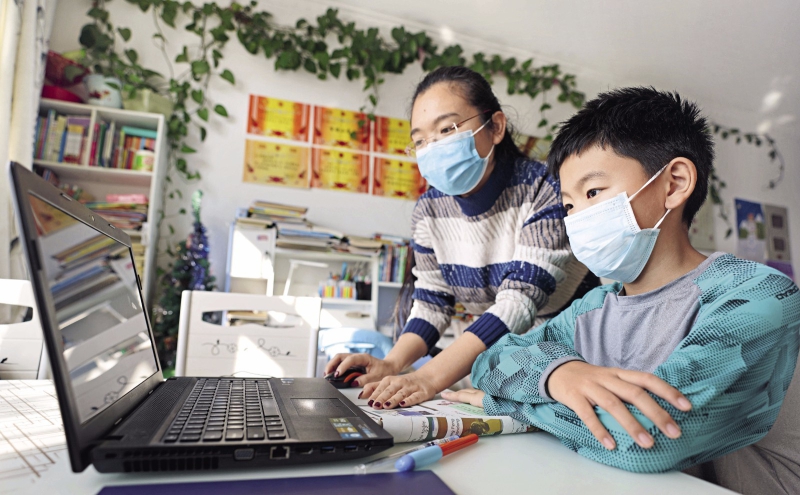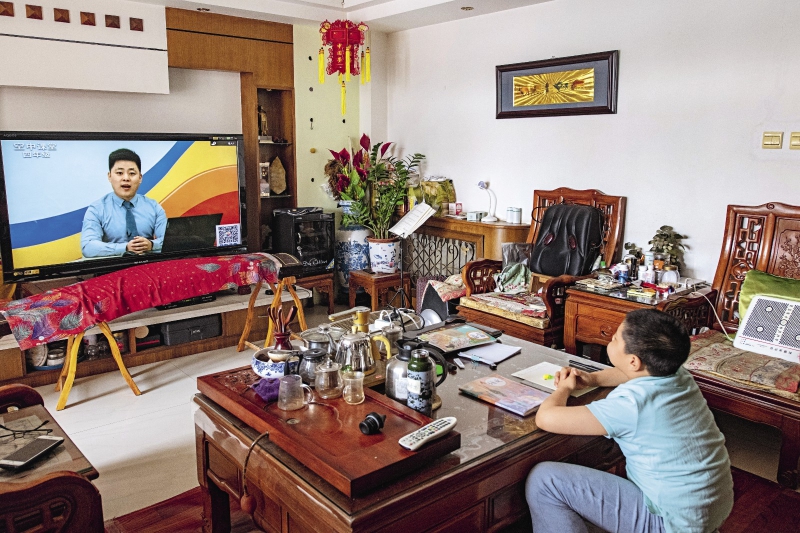"Teachers teach students through the Internet, and students can gain all kinds of knowledge through the Internet without leaving their homes.” This was a premise of the sci-fi children’s bookPipilu and Luxixi published two decades ago. Few could have imagined it becoming a reality earlier this year.
Liu Yelin, a third-grader in a residential community in Zouping City, Shandong Province, and his mother are learning about Chinese ancient civilization online at home on February 13, 2020.
The COVID-19 outbreak in 2020 changed the lives of people around the globe. The Chinese government encouraged people to stay at home to prevent and control the spread of the coronavirus. However, life needs to continue. The Ministry of Education required students to continue their studies via Internet during the period of in-person class suspension. Fortunately, this has become achievable thanks to the rapid development of networking and Internet technology, and the establishment of 5G networks. More than 300 million teachers and students from across the country congregated online, and online teaching, as a supplement tool to enhance learning in the past, has become the only choice for both educators and students during the epidemic.
Rush to Online Learning
Jiahe, a middle school student, gets up at 8 o’clock every morning and turns on his mobile phone to receive a list of daily learning tasks and assignments from his teachers on various subjects through a WeChat applet. The district where his school is located has many high-quality educational resources. The district education committee gathered high-quality teachers and recorded 30-minute online videos of various subjects for students of all grades. His school, based on its teaching practice, also recorded school-level online courses as a necessary supplement, and formulated detailed daily teaching schedules. Every weekend, he receives new learning tasks from the class advisor for the next week through the WeChat group, which contain video materials, class schedules, and homework materials.
This kind of semi-self-study learning method took students and parents a while to adapt to it. They had to figure out the way to download learning material and use the new system. But after a few weeks, parents became adept at using it.
The challenges students encounter stem more from the need of learning self-control without the constraints of school rules and discipline. The timetable and various tasks are what they need to meet and complete through self-discipline.
“One of the common problems children face while taking online classes is being easily distracted. Regardless of the academic ability of the children, this is the limitation of online teaching,” said a class advisor surnamed Sun. In order to make up for this shortcoming, teachers have thought of many ways to keeep students’ attention, such as holding regular video class meetings, and organizing regular online question and answer sessions to strengthen teacher-student communication. “In short, it is our goal to let the children feel that although they are in a virtual space of learning, teachers and classmates are always together,” said Sun.
A lecture is being recorded in a school in Tai’an City, Shandong Province, on March 6, 2020.
At present, there are generally two ways for online teaching in various schools: One is pre-recorded broadcasting, and the other is live streaming. The latter is considered to be more convenient for real-time communication between teachers and students. Xiang Wei is a mathematics teacher. He said that in order to conduct a live class online, he needs to spend more time on preparing for the class than before.
“In addition to sending electronic handouts to my students before the class, equipment debugging is also required to ensure that each student’s network connection and computer can work normally and optimally. Sometimes a trial lecture is needed to control the course’s rhythm,” said Xiang. In fact, the biggest change relates to the teaching plan. The reasoning and calculation of equations on the blackboard used to be a complete presentation of thinking logic underlying the solution. As an existing pen tablet has limited space to write on, it is a far cry from a blackboard in terms of flexibility and presenting details. In order to make up for this limitation, Xiang wrote down detailed steps in solving major and difficult problems of each session in the teaching plan and then sent them to his students for reference and review after class.
In addition, during his teaching, Xiang takes it upon himself to give the students detailed explanations and a comprehensive summary concerning difficult and important math problems apart from giving directions for simple problems. Although he was often faced with cameras being shut down by disinterested or distracted students during class, he still required the students to actively show their solutions and ideas through the roll call, so as to consolidate their knowledge and make them part of the group. After class, in addition to normal homework, he also provided the students with corresponding supplementary practice materials to ensure that they achieve the purpose of knowledge consolidation.
Whether it is recorded broadcasting or livestreaming, both teachers and students are adapting to the new models of educational delivery. “This is a large-scale educational experiment, which directly advances online education to a whole new level,” said Zhu Yongxin, a member of the National Committee of the Chinese People’s Political Consultative Conference (CPPCC).
Explorations in Practice
Yizhong’s mother has been anxious recently because her child has been studying online for nearly three months at home, and she has no idea how effective it is. “Although the school has organized several online exams, and the form and structure basically simulate the real scene, I still feel that it cannot reflect the real level,” said the mother.
The mother’s qualm is not unfounded. “Online teaching is demanding on children’s self-learning ability and self-control, which is not a uniform characteristic in all students. It will bring about polarization of students’ performance after in-person classes are restored,” said a eighth grade teacher surnamed Gao.
“I personally think that online teaching needs more investment in courseware production, which is an advantage of the Internet. Efforts of better art design are required in order to attract students,” said Wang Lufan, a teacher of high school mathematics. She thinks that it is more suitable for more displayable courses like English language teaching to go online, but the high school mathematics she teaches pays more attention to logical reasoning and problem-solving processes, a fact which makes her feel a little powerless.
On April 15, 2020, a pupil in a community in Shijingshan District, Beijing is watching an online lesson at home.
Physics teacher Zhang Ting sent the experimental equipment to her students’ homes. She interacted with the students to guide experiments in the live webcast class, and then let students send the experiment process to her through photos or videos to test their understanding of the principles. “Physics is an experimental science. Teenagers like to do experiments. I feel that there is little difference between online teaching and offline teaching,” she said.
Yixuan, a 10th grader, enjoys the learning experience at home because she can replay the video of online courses. “The teacher usually speaks fast during class, and note-taking is a great challenge. With the online course playback, I can take notes easily. Where there’s something I don’t understand, I can watch the lecture again and again until I fully digest it,” she said, and felt that after three months of online learning, her self-learning ability has improved. The part she likes the most is that teachers of all subjects could answer questions online at any time, which is more convenient than making an appointment before meeting a teacher in their offices in the past.
As a male student, Xiaoyu’s favorite part of the online class is that the student has a speed-up function. If he encounters a teacher who speaks slowly, he appreciates the ability to adjust the playback speed of their video to his satisfaction by operating the software. The only downside of having online classes at home was that he could not have fun with his classmates. Although the physical education teacher also recorded video lessons, since there was no supervision, he often muddled through. Recently, he played a bit more online games, and his score on the progress test in math declined as a result. He realized the importance of self-discipline, and has made three rules with his mother: He should control the time spent on gaming within a reasonable range, improve in physical exercise, and seek out healthy entertainment.
In recent years, with the progress of data analysis technology, evaluation software to assess the effects of teaching has been adopted by some educational institutions. After explaining a difficult knowledge point, the teacher will ask students to practice in the classroom. The students’ answers are fed back to the teacher through the system, quickly analyzing the correct rate. If the accuracy is high, the teacher will continue the lecture and consolidate the same knowledge points through more exercises; if the accuracy is low, the teacher will explain the relevant knowledge points again. If the analysis software is developed relatively well, the teacher can also see the reason why the students make mistakes.
“The effect of online education is directly related to the development level of the teaching system. By taking advantage of digitization of education and online teaching, the epidemic may be an opportunity to promote educational reform,” said Zhu Yongxin.
Complementary Online and Offline Education
With the COVID-19 epidemic now under effective control, the senior students in Beijing’s high schools have returned to school since April 27. Soon after, students of other grades will gradually return to their school campuses, and online teaching measures taken under the epidemic will also complete their historic mission. What impacts will they have on the trend of education in future?
“After the epidemic is over, priority will still be given to offline education. But this epidemic has had a positive effect on online teaching. For example, during the epidemic, we set up some one-hour exercise classes for high school students, which have won great support. This class will continue after our school opens again,” said Wang Lufan.
“Our organization started with face-to-face classes at first. As it was inconvenient for some students from other provinces to come to attend in-person classes, we opened an online live streaming system in 2015. Then we slowly discovered that online classes have many advantages, such as saving on commute time, and flexibility in class format. A face-to-face class usually takes two to three hours, however, elements such as lecturing and exercising are not suitable for a longer duration of time, but scattered and short periods of time are more suitable. Therefore, online teaching will be more advantageous than face-to-face teaching,” said Zhang Ting. “I personally think that face-to-face teaching and online teaching each have their own advantages and disadvantages, and one will not replace the other. It should be decided by the course demands and the needs of students.”
Xiang Wei also felt deeply impressed by the online teaching during the epidemic. “It is true that technology can change lives. Online teaching was basically inaccessible in the past, with network and equipment problems being real obstacles. But modern technology makes all this possible. Secondly, in the face of the epidemic, teenagers are still eager to learn knowledge and willing to overcome all obstacles. This is indeed the hope of our nation and a powerful driving force for our nation,” he said.
Xiang believes that future education will definitely have a place for online education. Because of the epidemic, online education will be integrated into the current education system more quickly. The many advantages of online education can complement existing traditional education models.


